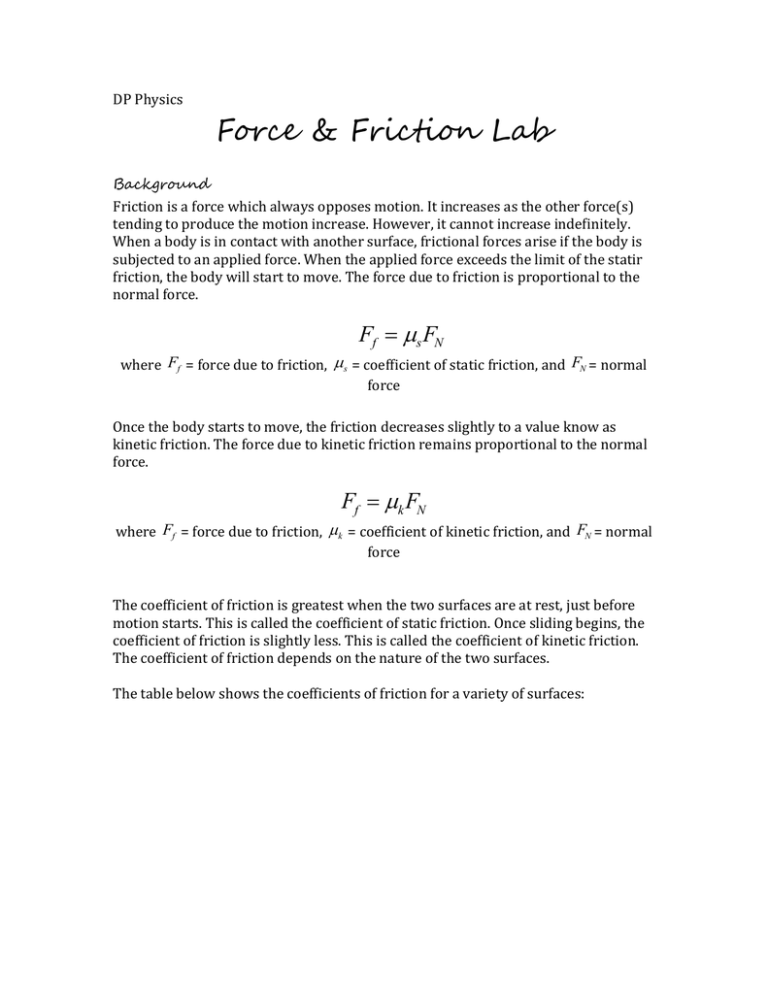Friction lab
advertisement

DP Physics Force & Friction Lab Background Friction is a force which always opposes motion. It increases as the other force(s) tending to produce the motion increase. However, it cannot increase indefinitely. When a body is in contact with another surface, frictional forces arise if the body is subjected to an applied force. When the applied force exceeds the limit of the statir friction, the body will start to move. The force due to friction is proportional to the normal force. Ff = ms FN where Ff = force due to friction, m s = coefficient of static friction, and FN = normal force Once the body starts to move, the friction decreases slightly to a value know as kinetic friction. The force due to kinetic friction remains proportional to the normal force. Ff = mk FN where Ff = force due to friction, m k = coefficient of kinetic friction, and FN = normal force The coefficient of friction is greatest when the two surfaces are at rest, just before motion starts. This is called the coefficient of static friction. Once sliding begins, the coefficient of friction is slightly less. This is called the coefficient of kinetic friction. The coefficient of friction depends on the nature of the two surfaces. The table below shows the coefficients of friction for a variety of surfaces: Purpose How is the coefficient of static friction influenced by the nature of the contact surfaces? How does the coefficient of static friction compare to the coefficient of kinetic friction for the same surfaces? Materials - 1 m length of fishing line - Block of wood with different surfaces (friction block) and small eye screw - Extra blocks of wood - Masses of known mass - Small basket - Desk or table - Electronic balance - Tape Procedure Set-up: 1. Record the mass of the blocks and the basket. 2. Tie the fishing line to the eye screw. 3. Tie the other end of the line to the basket handle and hang the basket off the end of a table. Place the block in the centre of the desk/table. Part 1 – Static Friction 4. Gently add mass to the basket 5. Continue to gradually add mass until the block starts to slide. 6. Record the total amount of mass in the basket that finally caused the block to slide. 7. Repeat steps 4-6 with the same system. 8. Repeat steps 4-7 with extra block of wood on top of the original block. 9. Repeat steps 4-8 with a third block of wood on top. 10. Repeat steps 4-9 so that a different surface material is in contact with the table. 11. Calculate the average coefficient of static friction for each material. Part 2 – Kinetic Friction In this case, the measurements are made as the block is sliding. The general idea is to tap the block constantly to overcome static friction and initiate sliding. 12. Use the same set-up as part 1. 13. Start with approximately half of the mass requited to initiate sliding in part 1. 14. Tap the block with your finger. Judge whether the block moves with a constant velocity. If it does, record the mass in the basket. If it does not, add more mass to the basket and repeat until you see constant velocity. 15. Repeat steps 13-14. 16. Repeat steps 13-15 with an extra block of wood on top of the original block. 17. Repeat steps 13-16 with a third block of wood on top. 18. Calculate the average coefficient of kinetic friction. Data **Remember to include in your data and calculations: - uncertainties on all measurements (with explanation if necessary of how you arrived at this uncertainty) - error propagation: for your calculation of μ in each case, and also when the average μ is calculated. Mass of block with eye screw: _________________ Mass of extra block: _____________ Mass of 2nd extra block: ________________ Mass of empty basket: ______________ Part 1 – Static friction Surface 1: _____________ Total mass of block(s) (g) Normal force of block(s) (N) Mass in basket (g) Total Force due Coefficient mass of to gravity of static basket (g) of the friction basket (N) Average coefficient of static friction Surface 2: _______________ Total mass of block(s) (g) Normal force of block(s) (N) Mass in basket (g) Total Force due Coefficient mass of to gravity of static basket (g) of the friction basket (N) Average coefficient of static friction Part 2 – Kinetic friction Surface: _____________ Total mass of block(s) (g) Normal force of block(s) (N) Mass in basket (g) Total Force due Coefficient mass of to gravity of kinetic basket (g) of the friction basket (N) Average coefficient of kinetic friction Plot graphs of your data (Force due to friction vs. Applied force) Discussion Questions to consider: 1. 2. 3. Error: What are the possible factors that may have contributed to systematic and/or random error in this experiment? Be specific and reasonable, and differentiate between these two types of error. How does the coefficient of static friction vary with mass of the blocks? With the surface material? Are these results consistent with what you expected based on theory and your knowledge of friction? Explain (using scientific reasoning). How does the coefficient of static friction compare to the coefficient of kinetic 4. friction for the same material? Is this the trend that you expected? Explain (using scientific reasoning). What are there no units for the coefficient of friction? Application Questions: 1. Why are anti-lock brakes in cars more effective on slick roads than regular brakes? (Anti-lock brakes are used in cars so that when someone slams on their brakes, they lock for a split second and then release, then lock for a quick second again, and so on, rather than staying locked continually.) You will be scored on analysis, evaluation, and communication.


